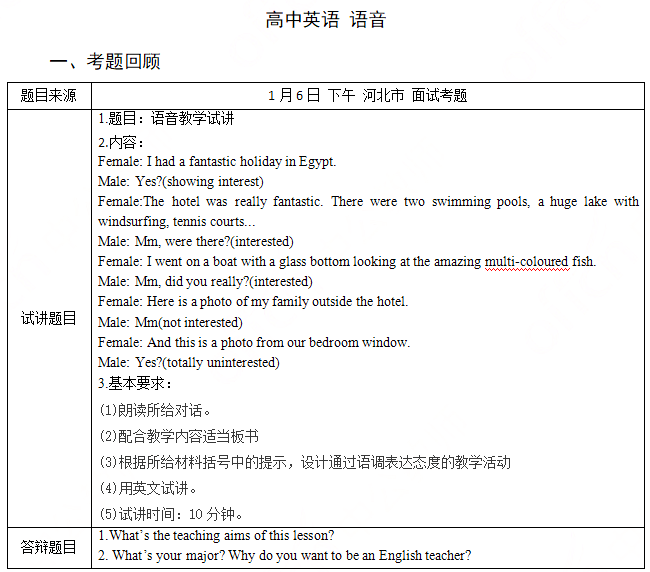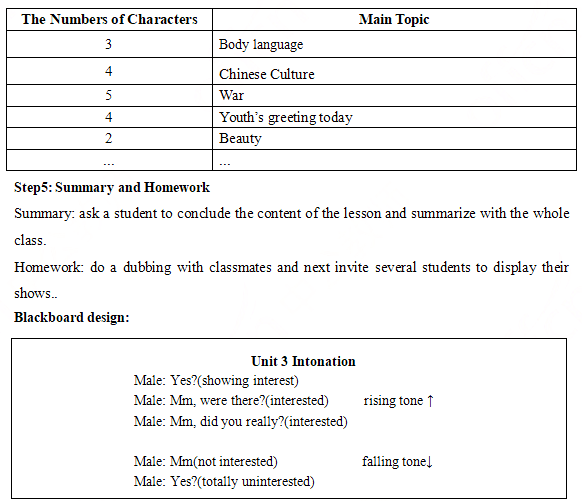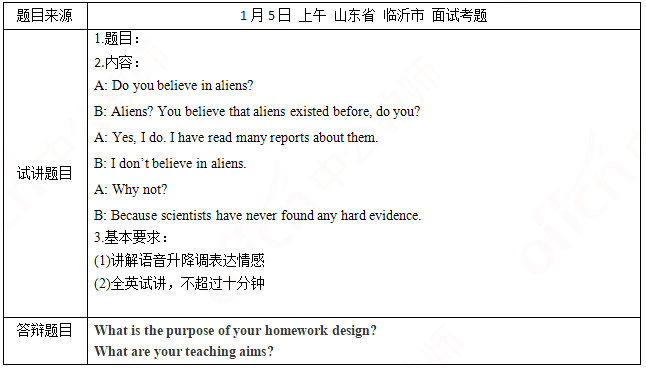问答题Practice 1 Directions: Read five students’ talks about traveling around Europe using an Inter-Rail ticket. The ticket allows people under the age of twenty-six to travel wherever they want within Europe for one month. For questions 1 to 5, match the n
题目
相似问题和答案
第1题:
In societies with low power distance power is distributed more equally and people want that no one gains too much power. Central and northern Europe such as Germany and Anglo-Saxon countries such as () are typical such societies.
解析:本句参考译文:在权力距离程度低的国家,权力分布更加平均,人们期望没有人获得太多权力。中欧和北欧(例如:德国)、盎格鲁-萨克逊国家(例如:__________)就是典型的这一类国家。
第2题:

二、考题解析
【教案】
Teaching Aims:
Knowledge aim: Students will master the content about hobbies.
Ability aim: Students can improve their writing ability about hobbies, such as drawing.
Emotional aim: Students will foster a hobby and know how to keep it.
Teaching Key Points:
Students know the content about hobbies and can improve their writing ability about hobbies.
Teaching Difficult Points:
Students can learn how to write, basing on their hobbies..
Teaching Methods:
Communicative teaching method, task-based teaching method, situational teaching method.
Teaching Aids:
PPT, Blackboard and so on
Teaching Procedures:
Step 1: Warming up
1.Greetings
2. Show two pictures about hobbies , ask all students to observe and describe.
Step 2: Pre-writing
1. Divide students into two groups, group A and group B and ask them to read the the dialogue.
2. Lead students to summary the main idea.
3.Read the dialogue by themselves again, then ask them some questions to get details.
(1) What are they fond of?
(2) How about drawing, what can it teach you?
(3) Where will they go?
4. Ask students to work in groups and discuss, do a survey on hobbies and reason, collecting key points.
Step 3: While-writing
Students write an article within 20 minutes.
Step 4: Post-writing
1.Self editing: students work in pairs to check if there are faults in spelling and grammar.
2.Sharing: choose 1-2 writing and show it on the screen.
3.Evaluating: appreciate and give comments.
Step 5: Summary & Homework
Summary : students look at the blackboard and summarize this class.
Homework:students talk about their hobbies to their friends or parents.
Blackboard design:

第3题:
A、travel around the world
B、become travel agents
C、visit family members
D、help other people
第4题:
第5题:
一、考题回顾

二、考题解析
【教案】
Teaching aims:
Knowledge aim:
Students will master the grammatical point -- the appositive clause.
Ability aim:
Students can apply today’s grammar knowledge to daily communication.
Emotional aim:
Students will have the interest towards foreign cultures.
Key and difficult point:
Key Point: Students will be able to understand and use the appositive clause.
Difficult Point: Students can get to know more about foreign countries actively.
Teaching procedure:
Step 1: Warming-up
1. Daily greeting.
2. Show some pictures about Canada and let some students introduce the knowledge they know about this country.
Step 2: Presentation
1. Read the whole passage for students and ask them to fill in the blanks like this, then check the answers:
The they could cross the whole continent was exciting.
Some people have you can cross Canada in less than five days.
They forget Canada is 5,500kilometres from coast to coast.
2. Let students observe these sentences and work in pairs to find what they have in common.
3. Draw a conclusion that the appositive clause is used to explain the noun or pronoun in front of it, the word “that” often serves as a conjunction in this clause.
Step 3: Practice
1. Choose which one is an appositive clause.
The suggestion that we should participate in the competition is worth considering.
The suggestion that he gave is worth considering.
2. Fill in the blanks with proper conjunctions and then translate them.
a. The teacher is trying her best to reduce the fear of students they will fail the exam.
b. He always asks me the question those people are trustworthy.
Step4: Production
Ask students to take part in the group work. Imitate the passage to introduce a place that they are familiar with, try to use the appositive clause.
Invite some groups to share their introductions.
Step5: Summary and Homework
Summary: ask a student to conclude the grammatical rule and the main idea of the passage.
Homework: find more information about Canada and make a travel plan.
Blackboard design:

1.What other exercises can be used in the practice part?
2.Please introduce yourself.
2.I am very glad to stand here to make a short self-introduction. As a student who majoring in English, I possess a strong interest in English and the culture of English-speaking countries. Plus, I have been dreaming to become a teacher since I was in primary school. From my point of view, teaching English to students just like constructing a bridge between their little world and the broad outside space. That’s why I participate in this test and I truly hope to fulfill my dream. Thank you.
第6题:
Which of the following is TRUE about the plan?( )
A. Ninety-five theatres have received funding.
B. Everyone will get at least one free ticket.
C. It may not benefit all the young people.
D. Free tickets are offered once every day.
第7题:

二、考题解析
【教案】
Teaching aims:
Knowledge aim:
Students can master the intonation of showing their attitudes.
Ability aim:
After this lesson, students can practice their listening and speaking ability through group work.
Emotional aim:
Students are able to love learning English after this lesson.
Key and difficult point:
Key Point: master the intonation of showing their attitudes.
Difficult Point: cultivate the interest of students’ learning English.
Teaching procedures:
Step 1: Warming-up
1. Greetings.
2. Play a video about a person who is shopping at a store and has a conversation with the shop assistant. And ask students to answer some questions: Does this customer want to buy the clothes? Give the reason
Step 2: Presentation
1.Ask students to listen the conversation carefully and the teacher reads the conversation that today needs to learn and ask students:
Which part does the male show the interest? Give the reason
And which part does the male show the uninterested? Give the reason
2.Then present the conversation on the PPT, and ask students to listen to the conversation again, pay attention to the intonation of male’s answers. And ask students to answer some questions:
When male shows the interest to the content of female’s saying, what kind of intonation does he use? Uninterested, what’s intonation?
3. Then lead the students to conclude the rules of intonations of showing their attitudes. At the same time, write the male’s words on the blackboard with the help of symbols of rising tone and falling tone.
Step 3: Practice
1.Ask students to read this conversation after the tape.
2.Role-play: Ask students to practice this conversation with their partner and after 5 minutes, invite some students to read this conversation for all the students.
3. Dubbing: Ask students to look at a short video about a conversation between a Chinese student and another foreign student. But this video only has the frames, but doesn’t have the sound, which needs students to finish dubbing with their deskmates in given 10 minutes. Then invite several students to show their conversation with all the students.
Step4: Production
Make stories: Ask students to use the knowledge of intonation to make a short story according to the chart. Before this, divide the students into several groups with different persons and ask the representatives to get their topic through the way of random draw.

1.What’s the teaching aims of this lesson?
2. What’s your major? Why do you want to be an English teacher?
There are three aims: knowledge aim,ability aim and emotional aim.
Knowledge aim:
Students can master the intonation of showing their attitudes.
Ability aim:
After this lesson, students can practice their listening and speaking ability through group work.
Emotional aim:
Students are able to love learning English after this lesson.
2.
My major is medicine. But I like English. And my biggest hobby is learning and speaking English. In my daily life, I like to go abroad to travel and reading English novels. I think English is more useful and attracting for me than my major, medicine.
第8题:
We are planning to go on a trip to Europe next month.
第9题:
一、考题回顾

二、考题解析
【教案】
Teaching aims:
Knowledge aim:
Students will master the basic knowledge of using intonation to express their own emotion.
Ability aim:
Students will express themselves with correct intonation naturally and fluently.
Emotional aim:
Students will be interested in and curious about unexplained things.
Key and difficult point:
Key Point: Students will master the pronunciation rules of intonation.
Difficult Point: Students can use rising and falling tones naturally in their daily life.
Teaching procedure:
Step 1: Warming-up
1. Greetings.
2. Show students a documentary clip about Mysterious World.
Step 2: Presentation
1. Let students listen to the tape, then repeat the dialogue, and answer the questions: What is the people’s attitude towards aliens? How can you feel it from the tone of their saying?
2. Give students more sentences and let them read by themselves. Guide them to find out the rule of intonation.
3. Conclude the rule of intonation:
General question: raising tone used to raise a question.
Rhetorical question:
The first part is spoken with a falling intonation, the second part with a rising intonation, which is used to raise doubt.
The first part is spoken with a falling intonation, the second part with a falling intonation, which is used to emphasize a point, just to get the audience think or ask deliberately.
Step 3: Practice
1. Read the conversation and example sentences loudly and feel the emotion.
2. Ask students give more disjunctive and rhetorical question sentences.
Step4: Production
1. Role-play: ask students to practice a new dialogue on the screen in pairs using proper intonation.
2. Dubbing game
Step5: Summary and Homework
Summary: ask a student to conclude the lesson and summarise for the whole class.
Homework: write a short play, rehearse in groups, and show us in the next class.
Blackboard design:

What is the purpose of your homework design?
What are your teaching aims?
Knowledge aim:
Students will master the basic knowledge of using intonation to express their own emotion.
Ability aim:
Students will express themselves with correct intonation naturally and fluently.
Emotional aim:
Students will be interested in and curious about unexplained things.
第10题:
What kind of questions should we ask our students when we want to give them a reason to read?
The questions should have a good general idea of what the text is about, should be concerned with the general meaning or with the most important points of the text, and not focus on minor details, and should be fairly easy to answer and not too long.
略
